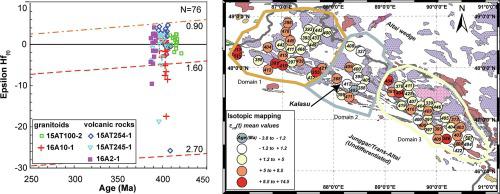当前位置:
X-MOL 学术
›
J. Asian Earth Sci.
›
论文详情
Our official English website, www.x-mol.net, welcomes your feedback! (Note: you will need to create a separate account there.)
Constraints of zircon Hf isotopes on ancient crustal reworking in the Early Paleozoic Altai accretionary wedge, Central Asian Orogenic Belt
Journal of Asian Earth Sciences ( IF 3 ) Pub Date : 2020-11-01 , DOI: 10.1016/j.jseaes.2020.104538 Arnaud Broussolle , Yingde Jiang , Min Sun , Yang Yu , Jean Wong , Tan Shu , Kang Xu
Journal of Asian Earth Sciences ( IF 3 ) Pub Date : 2020-11-01 , DOI: 10.1016/j.jseaes.2020.104538 Arnaud Broussolle , Yingde Jiang , Min Sun , Yang Yu , Jean Wong , Tan Shu , Kang Xu

|
Abstract A debate exists on whether the deep crust of the Altai Orogenic Belt contains ancient crustal components. To further address this issue, geochemical analyses and zircon hafnium isotopic measurements were conducted on five Devonian magmatic rocks from the Southern Chinese Altai. Three volcanic rocks have rhyolitic compositions and two other intrusions have granite and granodiorite compositions, respectively. These samples all have calc-alkaline, peraluminous compositions and “arc-related” trace element signatures, marked by enrichment in large-ion lithophile elements relative to many of the high field strength elements. Hf-in-zircon isotopic data for these rocks show variable eHf(t) values ranging from −25 to +5, with corresponding TDMc model ages varying from ca. 2.7 to ca. 0.9 Ga. These findings represent the first report describing negative zircon eHf(t) values for the Devonian magmatic rocks of the region, documenting magmatic reworking of ancient crustal components. The very similar trace elemental patterns and indistinguishable zircon Hf isotopic characteristics, between the studied magmatic rocks and the pre-existing Ordovician accretionary wedge sediments (the Habahe Group), supports the notion that the magmatic rocks are derived from magmatic reworking of the wedge that contains ancient crustal components. The studied magmatism is synchronous with Middle Devonian anatexis of the Ordovician wedge at low-pressure/high-temperature conditions and extrusion of bimodal volcanic rocks occurred in Devonian extensional basins. These events have been collectively taken as proxies of Devonian lithospheric extension in the Chinese Altai. Integrated mapping of Hf isotopic data for the bulk S-type Devonian magmatism of the Chinese Altai shows different domains with dissimilar Hf isotopic signatures. This further indicates that the magma source, i.e., the Ordovician wedge, is compositionally heterogeneous and contains ancient crustal components.
更新日期:2020-11-01


























 京公网安备 11010802027423号
京公网安备 11010802027423号